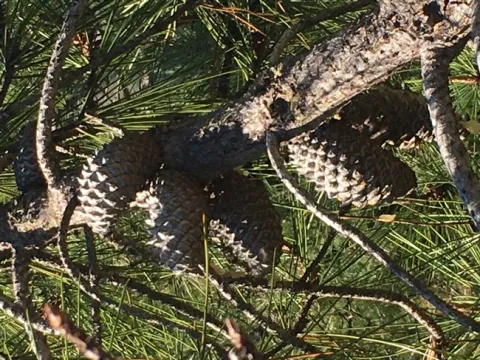
Pinus Attenuata
By Linda Lewis Griffith UCCE Master Gardener
Common Name: Knobcone Pine
Planting Zone: Sunset 2-10, 14-21
Size: 20-80 ft. tall, 20-25 ft. wide
Bloom Season: non-flowering
Exposure: Full sun
Pruning Needs: None needed
Water Needs: None needed
The knobcone pine is the most widespread of the three California closed-cone pines. Sporadic populations are found in southwestern Oregon, through California's Klamath Ranges, Coast Ranges and Santa Lucias down to Ensenada, Baja California. It also spreads across the Cascades, Modoc Plateau and Sierra Nevada. Elevations range from near sea level to almost 5,500 ft. on Mount Shasta. Knobcones frequently rely on marine layer condensation along the coast to supplement moisture during dry summer months. In many areas, including San Luis Obispo County, they are the dominant plant in serpentine and granitic outcroppings where little else is able to survive. Knobcone pine communities occur at the transition between chaparral, woodland and higher elevation forests. At lower elevations, they grow alongside chamise (Adenostoma fasciculatum), manzanita (Arctostaphylos ssp.) and various oaks (Quercus ssp.). At higher elevations, they are found among assorted conifers. Trees grow rapidly, forming a dense rounded crown that becomes open and irregular as they mature. Yellow-green needles are 3-5 inches long and occur in groups of 3. Multiple trunks are encircled by tight whorls of cones that tenaciously cling to the tree and give it its name. Layers of cones can be covered by new growth of wood. When the tree finally burns it contains all of the seeds and cones it has produced over its lifetime. Lifespans are relatively short; while some trees survive 75-100 years, most die by 60 years. Knobcones are serotinous, meaning reproduction is completely dependent on fire. Cones are sealed with a hard resin and require extremely high temperature to open. Once burned, they open as the ground is cooling and continue opening for at least 4 years. Small, delicate seeds are wind dispersed and can be carried well beyond the range of the fire. Birds and squirrels also aid in the dissemination of seeds. Knobcone seeds are among the earliest to germinate. Seedlings are drought tolerant and able to take root in poor soil.

